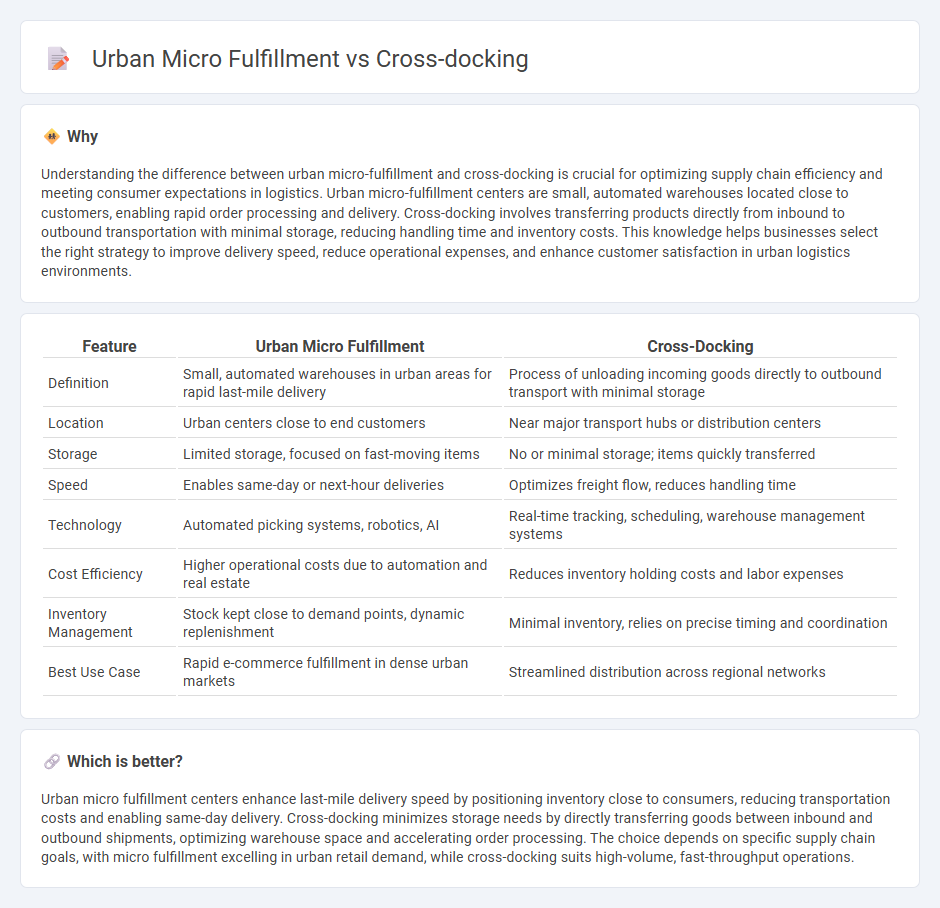
Urban micro-fulfillment centers streamline last-mile delivery by strategically locating inventory in dense urban areas, reducing transit times and enhancing customer satisfaction. Cross-docking optimizes supply chain efficiency by directly transferring goods from inbound to outbound transportation with minimal storage, accelerating order processing and lowering inventory costs. Explore the advantages and tailored applications of both strategies to transform your logistics operations.
Why it is important
Understanding the difference between urban micro-fulfillment and cross-docking is crucial for optimizing supply chain efficiency and meeting consumer expectations in logistics. Urban micro-fulfillment centers are small, automated warehouses located close to customers, enabling rapid order processing and delivery. Cross-docking involves transferring products directly from inbound to outbound transportation with minimal storage, reducing handling time and inventory costs. This knowledge helps businesses select the right strategy to improve delivery speed, reduce operational expenses, and enhance customer satisfaction in urban logistics environments.
Comparison Table
| Feature | Urban Micro Fulfillment | Cross-Docking |
|---|---|---|
| Definition | Small, automated warehouses in urban areas for rapid last-mile delivery | Process of unloading incoming goods directly to outbound transport with minimal storage |
| Location | Urban centers close to end customers | Near major transport hubs or distribution centers |
| Storage | Limited storage, focused on fast-moving items | No or minimal storage; items quickly transferred |
| Speed | Enables same-day or next-hour deliveries | Optimizes freight flow, reduces handling time |
| Technology | Automated picking systems, robotics, AI | Real-time tracking, scheduling, warehouse management systems |
| Cost Efficiency | Higher operational costs due to automation and real estate | Reduces inventory holding costs and labor expenses |
| Inventory Management | Stock kept close to demand points, dynamic replenishment | Minimal inventory, relies on precise timing and coordination |
| Best Use Case | Rapid e-commerce fulfillment in dense urban markets | Streamlined distribution across regional networks |
Which is better?
Urban micro fulfillment centers enhance last-mile delivery speed by positioning inventory close to consumers, reducing transportation costs and enabling same-day delivery. Cross-docking minimizes storage needs by directly transferring goods between inbound and outbound shipments, optimizing warehouse space and accelerating order processing. The choice depends on specific supply chain goals, with micro fulfillment excelling in urban retail demand, while cross-docking suits high-volume, fast-throughput operations.
Connection
Urban micro fulfillment centers enhance logistics efficiency by enabling rapid order processing in densely populated areas with limited space. Cross-docking complements this by minimizing storage time through direct transfer of goods between inbound and outbound transportation, reducing delivery lead times. Together, they optimize last-mile delivery, cutting costs and improving supply chain responsiveness in urban environments.
Key Terms
Transshipment
Cross-docking involves the rapid transfer of goods from inbound to outbound transportation with minimal storage time, optimizing transshipment efficiency in distribution centers. Urban micro fulfillment centers prioritize localized, small-scale inventory storage and quick order processing, enhancing last-mile delivery speed in densely populated areas. Explore the differences in transshipment techniques between these models to understand their impact on supply chain agility and cost reduction.
Last-mile delivery
Cross-docking accelerates last-mile delivery by streamlining the transfer of goods directly from inbound to outbound transportation, reducing storage time and inventory handling. Urban micro-fulfillment centers enhance speed and efficiency by strategically locating small warehouses closer to end consumers, facilitating rapid order processing in dense metropolitan areas. Explore deeper insights into how these logistics strategies transform last-mile delivery dynamics.
Inventory positioning
Cross-docking positions inventory by streamlining product flow directly from suppliers to customers with minimal storage, reducing holding costs and accelerating order fulfillment. Urban micro fulfillment centers strategically locate compact inventory closer to dense consumer areas, enhancing last-mile delivery speed and responsiveness for e-commerce and retail markets. Explore the impact of inventory positioning on supply chain efficiency to optimize your distribution strategy.
Source and External Links
Cross Docking: Definition, History, and Process - Cross-docking is a shipping method that transfers goods directly from inbound to outbound transportation with minimal storage, using methods like continuous flow, consolidation, and de-consolidation to optimize efficiency and reduce handling costs.
What Is Cross-Docking? Definition, Types & Advantages - Cross-docking is a supply chain strategy where goods are transferred directly from incoming to outgoing vehicles at a logistics facility, minimizing storage time and reducing costs while accelerating delivery.
Understanding cross-docking: A comprehensive guide - Cross-docking involves direct transfer of products from suppliers to customers or next destinations with minimal storage, classified into pre-distribution and post-distribution types, and including continuous, consolidation, and deconsolidation processes tailored for industries such as retail, manufacturing, and e-commerce.
 dowidth.com
dowidth.com